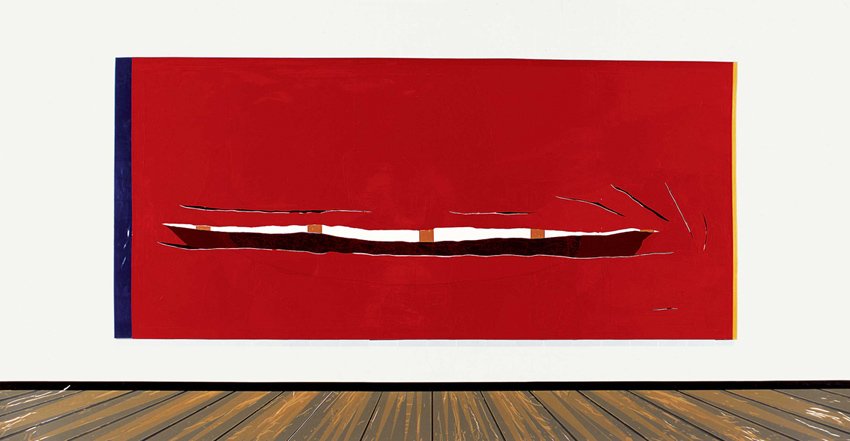The Vandalism of Barnett Newman's Paintings
Barnett Newman, a pivotal figure in Abstract Expressionism and Color Field painting, created works that provoke both profound admiration and controversy. As a Jewish American artist, his contributions to modern art are notable for their emphasis on spirituality, simplicity, and the exploration of the sublime. Yet, his works have also been targets of vandalism, revealing deeper societal tensions and misunderstandings surrounding abstract art. This article delves into the instances of vandalism against Newman's paintings, exploring the motivations behind these acts, their impact on the art world, and the challenges of restoration.
Barnett Newman: A Brief Overview
Bernard Gotfryd, Barnett Newman, Painter, 1969. Image from Wikimedia Commons.
Barnett Newman (1905-1970) was an influential artist known for his minimalist approach, utilizing expansive fields of color and his distinctive "zips"—vertical lines that disrupt the color fields. His work was not merely a visual experience but an invitation to contemplate deeper existential and spiritual themes. Newman believed that art should be an encounter with the sublime, offering viewers a space for introspection and a sense of connection to a broader human experience. His Jewish heritage and the socio-political climate of his time deeply influenced his work, often reflecting themes of existential angst and the search for meaning in a post-Holocaust world.
The Series: Who’s Afraid of Red, Yellow, and Blue
Who’s Afraid of Red, Yellow, and Blue is a series of four large-scale paintings created by Barnett Newman between 1966 and 1970. The series is notable not only for its bold use of primary colors but also for being the target of vandalistic attacks. The title references Edward Albee's 1962 play Who’s Afraid of Virginia Woolf?, which in turn alludes to the Disney song "Who's Afraid of the Big Bad Wolf?" from 1933. This interplay of cultural references underscores the confrontational and challenging nature of the series.




Newman approached the creation of the first painting in the series without a preconceived plan, aiming for something distinct from his previous work and intentionally asymmetrical. As he painted the canvas red, he realized that only the other primary colors, yellow and blue, could effectively complement it. This decision inevitably invoked a dialogue with the De Stijl movement and, in particular, the works of Piet Mondrian. Newman sought to reclaim the use of these colors from the didactic rigidity he perceived in Mondrian's work, instead using them as a means of expressive freedom. This approach highlighted a fundamental difference in artistic philosophy, with Newman prioritizing emotional and spiritual expression over formalistic constraints.
The First Attack: Who’s Afraid of Red, Yellow, and Blue IV
Barnett Newman, Who’s Afraid of Red, Yellow, and Blue IV , 1969-1970, via Freunde Der Nationalgalerie
The first documented attack on Newman's work occurred on April 13, 1982, at the Nationalgalerie in Berlin. The target was Who’s Afraid of Red, Yellow, and Blue IV, the last major work Newman completed before his death. The perpetrator, Josef Nikolaus Kleer, a 29-year-old German student, damaged the painting with a security barrier, expressing outrage at what he perceived as an affront to the German flag and the German people. Kleer's actions were driven by a misinterpretation of the painting's content, conflating its abstract expression with political symbolism. This incident reflects a broader misunderstanding of abstract art and the tensions it can evoke, particularly in a society grappling with its past and identity.
Barnett Newman, Who’s Afraid of Red, Yellow and Blue IV, 1969-70. Security barrier, paper. Image from Art Damaged.
The restoration of Who’s Afraid of Red, Yellow, and Blue IV took two years, highlighting the challenges in repairing abstract art, where the restoration must respect the original intent and technique. The attack and subsequent restoration efforts also underscore the emotional and cultural weight that Newman's work carries, particularly concerning his identity as a Jewish artist in a post-war context.
The Infamous Second Attack: Who’s Afraid of Red, Yellow, and Blue III
Barnett Newman, Who’s Afraid of Red, Yellow, and Blue III , 1967. Image from Stedelijk Museum.
The most notorious attack on Newman's work occurred in 1986 at the Stedelijk Museum in Amsterdam. Gerard Jan van Bladeren, motivated by a visceral dislike of the painting's simplicity, slashed Who’s Afraid of Red, Yellow, and Blue III with a box cutter, causing extensive damage. The attack resulted in fifty feet of cuts across the canvas, irreparably altering its surface.
Thomas Raat, Who's Afraid of Red, Yellow and Blue After the Attack, 2006. Image from Mutual Art.
Van Bladeren's motivations are complex. He expressed disdain for the painting, which he felt was undeserving of its place in a prestigious museum. This sentiment was echoed by others who criticized abstract art for its perceived lack of skill and depth. However, the underlying issue may also involve anti-Semitic undertones, given Newman's background and the cultural context of the time. The fact that Van Bladeren felt justified in his actions and expressed no remorse highlights a disturbing disregard for the artistic expression and cultural heritage represented by the painting.
The Controversial Restoration
The restoration of Who’s Afraid of Red, Yellow, and Blue III became a contentious issue in the art world. The museum eventually enlisted the services of Daniel Goldreyer, an art conservator from Long Island, in 1991. Goldreyer claimed to have worked with Newman and assured that he could faithfully restore the painting. However, his methods were met with widespread criticism. Instead of selectively repairing the damaged areas, Goldreyer allegedly repainted the entire surface using a roller, a technique that dramatically altered the original texture and appearance of the work. This restoration was seen by many as a second act of vandalism, as it failed to respect the integrity of Newman's original creation.
The controversy surrounding the restoration highlights the delicate nature of conserving modern art. Unlike classical paintings, where techniques and materials are well-documented, modern artworks often involve unique methods that are difficult to replicate. The backlash against Goldreyer's restoration underscores the importance of preserving the artist's intent, not just the physical aspects of the artwork.
Collateral Damage: The Attack on Cathedra
Barnett Newman, Cathedra, 1951. Image from Stedelijk Museum.
In 1997, Gerard Jan van Bladeren struck again, this time targeting Newman's painting Cathedra (1951) at the Stedelijk Museum. Frustrated by the botched restoration of Who’s Afraid of Red, Yellow, and Blue III, van Bladeren once again used a box cutter to slash the canvas, leaving seven long cuts. Cathedra is a deeply spiritual work, featuring a deep blue field interrupted by two zips. It represents Newman's exploration of the sublime and his attempt to convey a sense of spiritual transcendence.
Barnett Newman, Cathedra After the Attack, 1997. Image from ArtWay.
Van Bladeren's attack on Cathedra was motivated by a complex mix of anger and misguided zeal. Ironically, he seemed to regard himself as a custodian of artistic integrity, retaliating against what he perceived as a violation of Newman's work through the previous restoration. This incident further complicates the narrative surrounding the vandalism of Newman's paintings, suggesting that the motivations behind such acts can be multifaceted and paradoxical.
The Cultural and Societal Implications
The repeated attacks on Newman's paintings reflect broader societal attitudes towards abstract art and the challenges it poses to traditional aesthetic values. Abstract art often elicits strong reactions, both positive and negative, as it challenges viewers to engage with art on an emotional and intellectual level, rather than through representational familiarity. Newman's works, with their minimalist approach and emphasis on color and form, are particularly provocative in this regard. They force viewers to confront their preconceptions about art and question the nature of beauty and expression.
Moreover, the attacks highlight the persistent undercurrents of anti-Semitism and cultural intolerance. Newman's Jewish heritage and the content of his work, which often engaged with themes of suffering and redemption, may have made him a target for those harboring bigoted sentiments. The desecration of his paintings can thus be seen as not just an assault on modern art, but also a broader attack on the values of diversity and open expression.
The Challenges of Restoration and Conservation
The restoration of vandalized artworks, especially abstract pieces, presents unique challenges. The primary goal is to repair the physical damage while preserving the artist's original intent and the artwork's authenticity. However, the subjective nature of abstract art complicates this process, as it is often difficult to determine the exact materials and techniques used. In the case of Newman’s work, the challenges were compounded by the need to replicate the smooth, almost imperceptible brushwork and the precise hues of his large color fields.
The controversy surrounding the restoration of Who’s Afraid of Red, Yellow, and Blue III illustrates the potential pitfalls of conservation efforts. The failure to adhere to accepted conservation practices and the perceived disrespect for the artist’s vision sparked outrage within the art community. It underscores the importance of transparency and adherence to ethical standards in the conservation of art.
Conclusion
The vandalism of Barnett Newman's paintings and the subsequent controversies over their restoration are not just isolated incidents of art destruction. They serve as reflections of broader societal tensions, including the reception of abstract art, the complexities of cultural identity, and the challenges of preserving artistic heritage. Newman’s work, with its emphasis on the sublime and the spiritual, continues to provoke strong reactions, highlighting the enduring power of art to evoke deep emotional and intellectual responses.
As we consider these acts of vandalism, it is crucial to recognize them as part of a larger discourse on the role of art in society. The destruction and restoration of Newman's paintings force us to grapple with questions about the value of art, the responsibilities of cultural institutions, and the ways in which art reflects and shapes our understanding of the world. In preserving the integrity of such works, we are not merely maintaining physical objects but safeguarding the cultural and spiritual dialogues they inspire.







